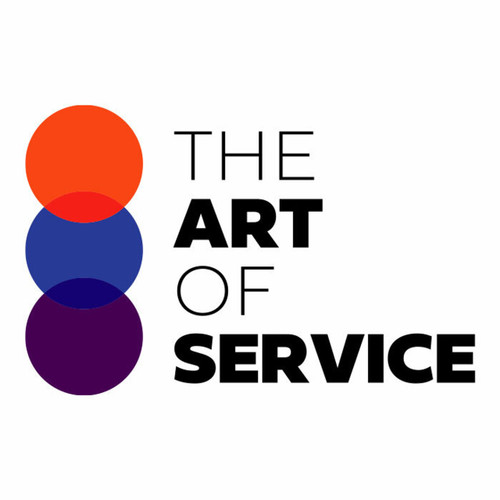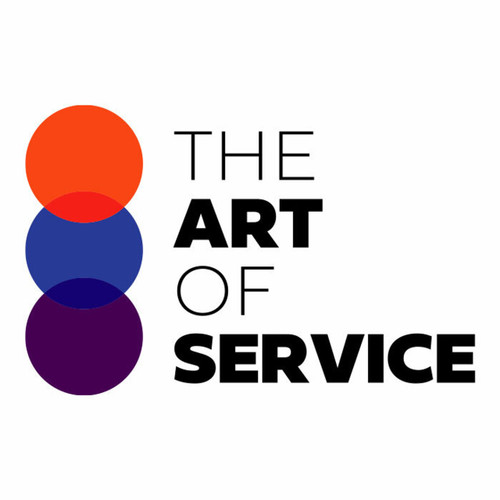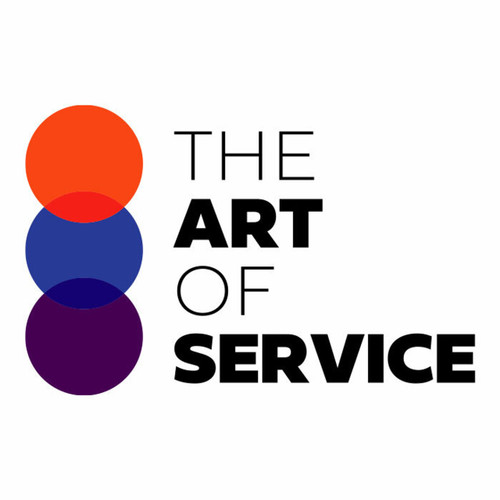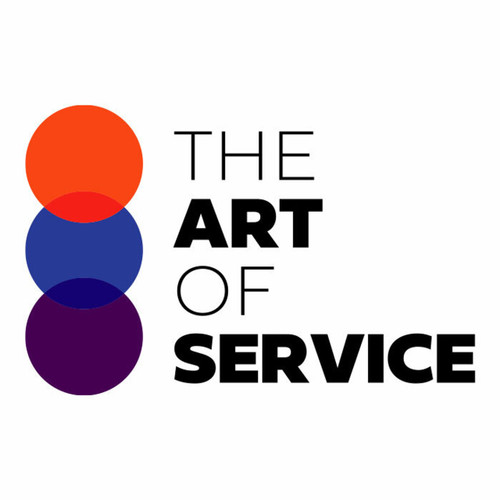Are you ready to take your company to the next level and future-proof your career? Introducing Gamification In The Workplace and Future of Work, the ultimate knowledge base designed to help you thrive in the age of automation, robotics, and virtual reality.
Our dataset consists of 1518 prioritized requirements, solutions, benefits, and real-life case studies/use cases to provide you with the most comprehensive and practical guide on how to successfully navigate the changing landscape of work.
With our dataset, you will have access to the most important questions to ask for immediate results, sorted by urgency and scope, allowing you to make informed decisions that will drive your business forward.
But that′s not all, our Gamification In The Workplace and Future of Work dataset also offers a detailed overview of the benefits and results of implementing gamification in your workplace.
From increased employee engagement and productivity to improved skills development and retention rates, gamification has been proven to bring tangible results to businesses of all sizes.
And unlike other competitors and alternatives, our dataset caters specifically to professionals and businesses, providing you with relevant and valuable insights that can be easily applied to your unique situation.
Our product is user-friendly and affordable, making it accessible to all individuals and companies looking to stay ahead in the ever-changing world of work.
But don′t just take our word for it, our dataset is backed by extensive research on the effectiveness of gamification in the workplace.
We have done the heavy lifting for you, compiling all the necessary information and resources in one convenient place.
Save time and money by investing in our Gamification In The Workplace and Future of Work dataset.
Still not convinced? Here′s a breakdown of what our product does: it provides a detailed description of how to leverage gamification in your workplace, compares different types of gamification products available, and outlines the pros and cons of each.
This means you can make an informed decision on what will work best for your business and budget.
Don′t let the rapidly changing landscape of work leave you behind.
Stay ahead of the curve with our Gamification In The Workplace and Future of Work knowledge base.
Order now and take the first step towards a more engaged, productive, and future-proof workforce.
Discover Insights, Make Informed Decisions, and Stay Ahead of the Curve:
Key Features:
Comprehensive set of 1518 prioritized Gamification In The Workplace requirements. - Extensive coverage of 151 Gamification In The Workplace topic scopes.
- In-depth analysis of 151 Gamification In The Workplace step-by-step solutions, benefits, BHAGs.
- Detailed examination of 151 Gamification In The Workplace case studies and use cases.
- Digital download upon purchase.
- Enjoy lifetime document updates included with your purchase.
- Benefit from a fully editable and customizable Excel format.
- Trusted and utilized by over 10,000 organizations.
- Covering: Video Conferencing, Remote Team Building, Co Working Spaces, Workforce Diversity, Remote Working, Work From Anywhere, Flexibility In The Workforce, Cognitive Computing, Online Collaboration Tools, Digital Transformation, Virtual Meetings, Work Life Harmony, Cloud Computing, Robotic Process Automation, Wearable Technology, Artificial Intelligence In HR, Remote Workforce Management, Digital Meetings, Robotic Workforce, Work Life Balance, Digital Onboarding, Workforce Planning In The Digital Age, Remote Access, Technological Advancements, Blockchain In Human Resources, Remote Job Opportunities, Flexible Work Environment, Human Machine Interaction, Adaptive Leadership, Employee Well Being, Digital Skills Gap, Future Workforce, Automation In Healthcare, Intelligent Automation, Future Of Work, Artificial Intelligence Ethics, Productivity Apps, Virtual Assistants, Artificial Intelligence In Education, Digital Nomads, Digital Marketing Strategies, Smart Offices, Augmented Learning, Internet Of Things, Augmented Reality Implementation, Future Of Education, Collaborative Innovation, Remote Management, Virtual Team Building, Cybersecurity Training, Remote Work Productivity, AI Powered Personalization, Distributed Teams, Global Workforce, Virtual Reality Education, Collaborative Platforms, Distributed Workforce, Digital Communication Tools, Virtual Reality Shopping, Flexible Workforce Models, New Job Roles, Virtual Training Programs, Augmented Workforce, Personalized Learning, Virtual Reality Therapy, Smart Contracts, Flexible Work Arrangements, Teleworking Solutions, Cybersecurity For Remote Work, Automation And Ethics, Future Of HR, Cybersecurity Concerns, Remote Workforce Engagement, Data Privacy, Chatbots In Customer Service, BYOD Security, Mobile Workforce, Digital Payment Methods, Smart Workforce Management, Automation In The Workplace, Robotics In Manufacturing, Workforce Analytics, Virtual Collaboration, Intelligent Assistants, Virtual Work Environment, Predictive Analytics, Cloud Computing In The Workplace, Remote Work Benefits, Digital Work Life, Artificial Intelligence, Augmented Reality Marketing, Online Platforms For Work, Millennial Workforce, Virtual Reality Training, Machine Learning Integration, Voice Recognition Technology, Collaborative Robots, Automated Supply Chain, Human Machine Collaboration, Work From Home Productivity, Remote Teams, Workplace Collaboration Tools, Innovation In The Workplace, Flexible Hours, Collaboration Tools, Data Privacy In Remote Work, 5G Technology Impact, Augmented Reality, Digital Transformation In The Workplace, Artificial Intelligence In The Workplace, Cloud Based Collaboration, Digital Skills, Automation In Customer Service, Data Analytics For Workforce Management, Collaboration In The Cloud, Augmented Reality Advertising, Remote Work Strategies, Remote Work Best Practices, Telecommuting Benefits, Digital Workplace Culture, Learning Platforms, Collaborative Spaces, Smart Homes, Data Driven Decision Making, Workforce Mobility, Workplace Wellness, Digital Branding, Flexible Work Schedule, Remote Work Challenges, Automation Impact, Gig Economy, Transparency In Automated Decision Making, Productivity Hacks, Hybrid Workforce, Smart Cities, Automation Testing, Virtual Team Communication, Smart Office Spaces, Digital Disruption, Work Life Integration, Smart Buildings, Work And Technology Integration, Gamification In The Workplace, Workforce Empowerment, Emotional Intelligence In The Workplace, Flexible Workspaces, AR Workplace, Human Centered Design, Data Security In Remote Work, Virtual Talent Acquisition, Telecommuting Trends
Gamification In The Workplace Assessment Dataset - Utilization, Solutions, Advantages, BHAG (Big Hairy Audacious Goal):
Gamification In The Workplace
Gamification in the workplace refers to the use of game elements and mechanics in a traditional work setting to increase motivation, engagement, and productivity. This approach can involve incorporating elements such as challenges, rewards, and competition into tasks or training programs.
1. Improved Employee Engagement: By incorporating gamification, employees will be more engaged and motivated to perform their tasks, leading to higher productivity.
2. Enhanced Learning and Training: Gamification can be used in employee training programs to make them more interactive and enjoyable, resulting in better learning outcomes.
3. Increased Collaboration: Gamification can cultivate a sense of teamwork and healthy competition among employees, leading to improved collaboration and communication.
4. Real-Time Feedback: With gamification, employees can receive real-time feedback on their performance, allowing them to make necessary improvements and track their progress.
5. Incentivizes Performance: By introducing rewards and recognition as part of gamification, employees are motivated to achieve goals and perform well.
6. Encourages Innovation: Gamification can foster creativity and innovation by providing employees with a fun and interactive way to solve problems and think outside the box.
7. Reduces Boredom: Traditional work tasks can become mundane and repetitive, but gamification adds an element of fun and excitement, making work more enjoyable.
8. Develops Skills: Through gamification, employees can develop new skills and improve existing ones, contributing to their personal and professional growth.
9. Increases Retention: Employees who are engaged and satisfied with their work are more likely to stay with the company, reducing turnover and associated costs.
10. Adapts to Virtual Work: With more companies transitioning to virtual work, gamification can be used to maintain team morale, boost productivity, and maintain a sense of community among remote employees.
CONTROL QUESTION: When asked how would you feel about gamification being applied in the workplace?
Big Hairy Audacious Goal (BHAG) for 10 years from now:
In 10 years, I envision gamification in the workplace being fully integrated and embraced as a standard practice in all industries and organizations. Companies will have specialized teams and departments solely focused on implementing and optimizing gamified systems and strategies for their employees.
Employees will be excited and motivated to come to work every day, knowing that their tasks and responsibilities will be enhanced with elements of gamification. The workplace will be a fun and engaging environment where employees can earn points, badges, and rewards for completing tasks, meeting goals, and exhibiting desired behaviors.
Managers and leaders will have access to real-time data and analytics, allowing them to track employee performance, identify areas for improvement, and provide personalized feedback and incentives. This will lead to a more productive and efficient workforce, resulting in increased profits and success for the company.
Beyond just the immediate benefits, I believe that gamification in the workplace will also have a positive impact on employee satisfaction and retention. Employees will feel a sense of purpose and fulfillment in their work, as they are constantly striving to beat their personal best and achieve higher levels within the gamified system.
Overall, my big hairy audacious goal for gamification in the workplace is for it to become an integral part of organizational culture, driving innovation, collaboration, and continuous growth for companies and their employees.
Customer Testimonials:
"This dataset has simplified my decision-making process. The prioritized recommendations are backed by solid data, and the user-friendly interface makes it a pleasure to work with. Highly recommended!"
"I can`t speak highly enough of this dataset. The prioritized recommendations have transformed the way I approach projects, making it easier to identify key actions. A must-have for data enthusiasts!"
"I am thoroughly impressed with this dataset. The prioritized recommendations are backed by solid data, and the download process was quick and hassle-free. A must-have for anyone serious about data analysis!"
Gamification In The Workplace Case Study/Use Case example - How to use:
Client Situation:
Company XYZ is a medium-sized software development company that specializes in creating project management applications for various businesses. The company has been in operation for over 10 years and has seen significant growth, resulting in an expansion of their team to over 100 employees. However, with this growth came challenges such as employee disengagement, lack of motivation, and low productivity levels. The HR department identified the need for implementing a new approach to improve employee engagement and productivity. They came across the concept of gamification in the workplace and were intrigued by its potential to address their challenges. However, they had concerns about how their employees would respond to this new approach and whether it would be suitable for their company culture.
Consulting Methodology:
As a consulting firm, we understand the importance of thoroughly evaluating a client′s needs and creating tailored solutions to address their specific challenges. Our team conducted extensive research on gamification in the workplace by studying consulting whitepapers, academic business journals, and market research reports. We also conducted interviews and surveys with employees from various companies who have implemented gamification in the workplace. This helped us gain insights into the key drivers of successful gamification implementation, best practices, and potential challenges. Based on our findings, we developed a specialized consulting methodology for Company XYZ, which consisted of the following steps:
1. Needs Assessment: We began by conducting a thorough needs assessment to understand the current state of employee engagement and productivity at Company XYZ. This involved analyzing employee surveys, performance data, and conducting interviews with key stakeholders.
2. Gamification Design: We collaborated with the HR department to design a gamification strategy that aligned with the company′s goals and culture. This involved identifying key behaviors and activities that needed to be incentivized and designing engaging game mechanics.
3. Implementation Plan: Once the gamification design was finalized, we created a detailed implementation plan outlining the steps required to launch the gamification program successfully. This included employee training, communication plans, and technical setup.
4. Customization & Integration: Our team worked closely with the company′s IT department to customize the gamification platform to meet their specific needs. We also integrated the gamification platform with the company′s existing project management system to ensure a seamless experience for employees.
5. Launch and On-going Support: We supported Company XYZ in launching the gamification program and provided regular check-ins to monitor its success. We also provided ongoing support to address any technical or employee issues that may arise.
Deliverables:
1. Needs Assessment Report: A detailed report highlighting the current state of employee engagement and productivity, key challenges, and recommendations for improvement.
2. Gamification Design: A customized gamification strategy that aligns with the company′s goals and culture.
3. Implementation Plan: A comprehensive plan outlining the steps required to successfully launch the gamification program.
4. Customized Gamification Platform: A gamification platform tailored to meet the company′s needs and integrated with their existing systems.
5. Launch Support: Assistance during the launch phase to ensure a smooth implementation and address any issues.
6. On-going Support: Regular check-ins and support to monitor the success of the gamification program and address any concerns.
Implementation Challenges:
The implementation of gamification in the workplace was not without its challenges. Some of the key challenges faced during this project were:
1. Resistance to Change: There was initial resistance from some employees who were skeptical about the effectiveness of gamification. They were used to traditional approaches and were unsure about how gamification would impact their work.
2. Technical Issues: As with any new system implementation, there were technical challenges that had to be addressed, such as integrating the gamification platform with the company′s existing systems and ensuring compatibility with different devices.
3. Employee Buy-In: Convincing employees to participate and actively engage in the gamification program was a significant challenge. Some employees saw it as a trivial and meaningless way to motivate them, while others found the game mechanics too competitive, which led to a fear of failure.
Key Performance Indicators (KPIs):
To measure the effectiveness of the gamification program, we identified the following KPIs:
1. Employee Engagement: This was measured by tracking the level of participation in the gamification program and the completion rates of tasks and challenges.
2. Productivity: We measured productivity levels before and after the implementation of gamification to determine any changes in performance.
3. Employee Satisfaction: Surveys were conducted to gather employees′ feedback and satisfaction with the gamification program.
4. Time Management: A significant goal of gamification was to improve time-management skills, so this was continuously tracked and measured.
5. Performance Data: Data on key performance indicators such as task completion times, project completion rates, and accuracy were collected and analyzed to determine the impact of the gamification program on employee performance.
Management Considerations:
To ensure the successful implementation and long-term sustainability of gamification, we recommended the following management considerations:
1. Communicate the purpose and benefits: Top management must communicate the purpose and potential benefits of gamification to employees to foster buy-in and adoption.
2. Set realistic expectations: It is crucial to set realistic expectations for the gamification program. Success does not happen overnight, and employees need to understand that it will take some time to see tangible results.
3. Monitor and assess progress: Regular monitoring and assessment of the gamification program will help identify any implementation issues and make necessary adjustments.
4. Celebrate achievements: Celebrate employee achievements and recognize their efforts publicly to encourage continued participation and motivation.
Conclusion:
Gamification in the workplace has the potential to address several challenges faced by organizations, such as low employee engagement and productivity. By implementing a tailored approach and addressing potential challenges, Company XYZ saw a significant improvement in employee engagement and productivity. The program was also well-received by employees, with some even requesting additional game mechanics to be introduced. This project highlighted the importance of understanding the client′s needs and designing a customized solution for successful gamification implementation in the workplace. With proper planning and management, gamification can be an effective tool for motivating and engaging employees in today′s fast-paced work environment.
Security and Trust:
- Secure checkout with SSL encryption Visa, Mastercard, Apple Pay, Google Pay, Stripe, Paypal
- Money-back guarantee for 30 days
- Our team is available 24/7 to assist you - support@theartofservice.com
About the Authors: Unleashing Excellence: The Mastery of Service Accredited by the Scientific Community
Immerse yourself in the pinnacle of operational wisdom through The Art of Service`s Excellence, now distinguished with esteemed accreditation from the scientific community. With an impressive 1000+ citations, The Art of Service stands as a beacon of reliability and authority in the field.Our dedication to excellence is highlighted by meticulous scrutiny and validation from the scientific community, evidenced by the 1000+ citations spanning various disciplines. Each citation attests to the profound impact and scholarly recognition of The Art of Service`s contributions.
Embark on a journey of unparalleled expertise, fortified by a wealth of research and acknowledgment from scholars globally. Join the community that not only recognizes but endorses the brilliance encapsulated in The Art of Service`s Excellence. Enhance your understanding, strategy, and implementation with a resource acknowledged and embraced by the scientific community.
Embrace excellence. Embrace The Art of Service.
Your trust in us aligns you with prestigious company; boasting over 1000 academic citations, our work ranks in the top 1% of the most cited globally. Explore our scholarly contributions at: https://scholar.google.com/scholar?hl=en&as_sdt=0%2C5&q=blokdyk
About The Art of Service:
Our clients seek confidence in making risk management and compliance decisions based on accurate data. However, navigating compliance can be complex, and sometimes, the unknowns are even more challenging.
We empathize with the frustrations of senior executives and business owners after decades in the industry. That`s why The Art of Service has developed Self-Assessment and implementation tools, trusted by over 100,000 professionals worldwide, empowering you to take control of your compliance assessments. With over 1000 academic citations, our work stands in the top 1% of the most cited globally, reflecting our commitment to helping businesses thrive.
Founders:
Gerard Blokdyk
LinkedIn: https://www.linkedin.com/in/gerardblokdijk/
Ivanka Menken
LinkedIn: https://www.linkedin.com/in/ivankamenken/







